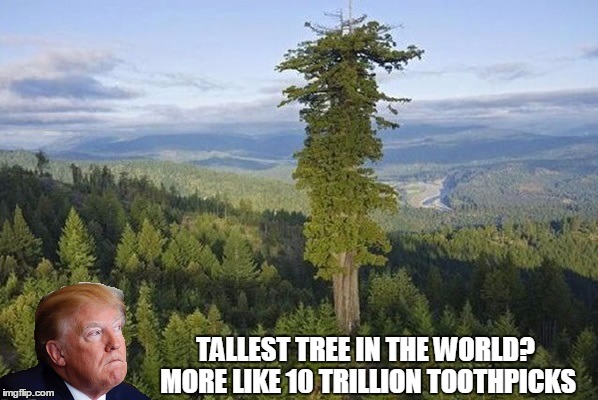
Want to Stop Climate Change? Start by Planting a Trillion Trees
Kathleen Parker / The Washington Post
(July 23, 2019) —Sometimes, big problems can be solved simply.
At the moment, our biggest problem — climate change — could be ended by simply planting trees. Okay, so 1 trillion trees, according to a Swiss study published this month in the journal Science. But how hard is that, really?
An equally serious and related problem is disappearing bees. Those cute little black-and-yellow-robed buzzers are essential to our survival, but our pesticides, fertilizers and climate change are killing them along with the insects we hate. Without bees, our ecosystems would collapse, and thus our food supply.
Over-the-top? Apocalyptic? Let’s just say, no. This is reality, and we have the means to change it: Plant trees, save bees. Since bees also like flowers, let’s go ahead and make America beautiful again. An emerging theory to combat crime in some parts of the country is called “busy streets.” Research has shown how simple cosmetic changes to urban communities — such as planting flower beds — can help reduce violence. And improve a city’s aroma to boot.
Saving bees and trees by planting with purpose would kill two birds, so to speak. If this sounds like a modern version of the Emerald City of Oz, I have no problem with that. Bees love poppies, which, though they provide no nectar, are an excellent source of pollen. That’s nothing to sneeze about, by the way.

Most people know that trees are good for them. They absorb carbon dioxide, thus purifying the air for our breathing pleasure. Carbon dioxide is also one of the main greenhouse gases, which trap heat in the atmosphere, leading to rising temperatures and climate change.
Estimates are that about 15 percent of emissions come from deforestation. Trees also curb other harmful gases, such as sulfur dioxide and carbon monoxide, again releasing pure oxygen into the air. If Congo’s 150 million hectares of forests were lost, it would generate about three times the world’s total emissions in 2012.
But scientists, including Thomas Crowther, a co-author of the trillion-tree study, were quick to point outthat planting trees alone wouldn’t work. And how does one go about planting 1 trillion trees? And where should they be planted?
Although tree-planting is a simple solution — effective and cheaper than any other remedy currently in circulation — it isn’t simply a matter of planting trees helter-skelter. A forest in the wrong place could have detrimental effects by upsetting the ecological balance.
But this seems a relatively easy obstacle to clear.
The countries with the most land available for building forests are Russia, China, Canada, Australia, Brazil — and the United States. The Switzerland-based researchers found that adding 1.2 trillion trees would reverse 10 years’ worth of harmful emissions. Over the decades, Crowther says those new trees would absorb about 200 billion tons of carbon from the atmosphere.
Several countries have signed up for reforestation, including the United States, which has seen an increase in its forestland, thanks in part to the Forest Service’s tree-planting initiatives. But we have to figure that the wreath of rainforests that wrapped around the globe until relatively recently was surely there for good reason. Satellite images show that the Amazon rainforest — the world’s largest — is disappearing at the rate of 1 1/2 soccer-field-size parcels per minute. What such decimation means to the planet’s future can’t be good — unless ridding the world of humans is Earth’s ultimate survival measure.
No trees, no birds, no bugs, no bees, no food, no humans. That’s pretty simple, too.
This past winter, a record share — nearly 40 percent — of honeybee colonies in the United States died, but bees aren’t the only ones disappearing. Forty percent of all the world’s insect species are in decline, according to another recent study, leading scientists to declare that Earth is experiencing the Sixth Great Extinction. Nobody likes bugs — until they’re gone and their purposes finally appreciated.
Insects nourish birds and fish, and serenade us to sleep. Animals pollinate 87 percent of flowering plant species. If current trends continue, there may be no insects by 2119, with one likely exception — the indestructible cockroach, whose sole purpose is apparently to recycle our messes, thus guaranteeing its survival after all else is gone.

Trump’s Trillion-Tree Bill To Subsidize Logging: Sponsored By Rep Funded By Logging Industry
(February 13, 2020) — Two years ago, when California’s deadly Camp Fire killed 85 people, President Trump and the GOP responded with a strategy that came straight from the logging industry: that the solution to fires is to cut down more trees. Since then we’ve heard and talked about how the administration exploited the crisis to help the industry. At the time, Sludge’s Alex Kotch made the connection between the denial rhetoric and seven-figure GOP donations from the Emmerson family, which owns the Sierra Pacific Industries logging company.
One of the key proponents of this strategy was a representative from Arkansas named Bruce Westerman, who has received twice as many campaign donations from the timber industry as he has from any other industry over the course of his career. Coincidentally, Westerman has a history of introducing logging-friendly bills under the guise of protecting forests.
As usual, time is a flat circle. Yesterday the GOP went to Axios to preview its Trillion Trees Act, which would subsidize buildings made of wood as part of its new climate denial 2.0 strategy of appearing to take action on climate change.
The lead sponsor? Bruce Westerman.

Though it didn’t mention Westerman’s prolific timber industry funding, Axios did make space to note some of the bill’s drawbacks: it doesn’t address deforestation around the world, it doesn’t have any actual emission-reduction goals, and the namesake Trillion Trees refers to the international program, whereas the US would only need to plant an extra 800 million trees annually to reach its 3.33 billion-tree-a-year share of those trillion.
To be fair, “The 800 Million Tree Bill” doesn’t have quite the same ring, so we’ll give them that. But unfortunately, per the headline of a NYT op-ed by three scientists yesterday, “planting trees won’t save the world.”
There are a number of reasons that trees alone won’t save us, especially if we don’t stop burning fossil fuels. As the authors explain, reforestation now is good, and will absorb carbon, “but this uptake merely replaces carbon lost when forests were cleared in the first place, usually long ago. Regrowing forests where they once flourished can undo some damage done in the past, but even a trillion trees can’t store enough carbon to head off dramatic climate changes this century.”

The planet has 3 trillion remaining trees but they could be gone in 300 years.
Ultimately, trees are only a stop-gap solution that buy us a few decades of carbon storage, even when the wood traps carbon by making buildings, because eventually the trees will die and the buildings will come down. And when they do, that carbon will be returned to the cycle.
But that may be overthinking it, considering this new plan to fight climate change with trees is really just a policy to give public money to the industry that cuts down trees.
Why the GOP is happy to provide the industry causing climate change with public money, but is reluctant to support the industries fixing it would be unclear, if OpenSecrets weren’t here to show us that the root of it is as simple as campaign contributions.
One day, the towering influence of industry-funded climate denial may fall. But until then, beware of deniers barking “Timber!”
Posted in accordance with Title 17, Section 107, US Code, for noncommercial, educational purposes.